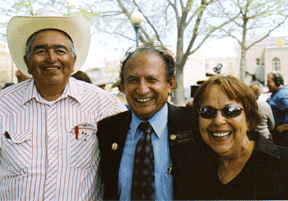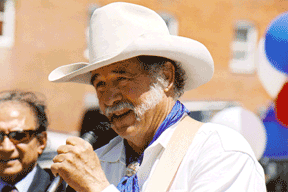
By Dick Foster, Rocky Mountain News fosterd@rockymountainnews.com or 719-633-4442, Rocky Mountain News, 101 West Colfax Avenue, Suite 500, Denver, Colorado 80202, 303-954-5000, Fax: 303-954-2568, http://wwwrockymountainnews.comTo submit a Letter to the Editor: letters@rockymountainnews.com

Sonya Doctorian's video journal: Branding calves at Muddy Valley Ranch http://cfapp2.rockymountainnews.com/video/popup-w.cfm?VID=051807ranch
Video: Not for sale to the Army
http://cfapp2.rockymountainnews.com/video/popup-w.cfm?VID=051807pinyonsigns
Slide show: A way of life in peril (26 compelling photos with thought-provoking captions)
http://cfapp2.rockymountainnews.com/photos/slideshow_main.cfm?xml=http://cfapp2.rockymountainnews.com
/photos/slideshows/051807lajunta/051807lajunta.xml&slideShowType=default&slideShowName=051807lajunta&dateCreated=05/18/07
 Governor Ritter getting ready to sign HB 1069 5/3/07 |
|
| McKinley | |
 Kester & McKinley |
 |
| Governor Ritter getting ready to sign HB 1069 5/3/07 | |
 |
|
| Happiness over HB1069 signing. |
http://blogs.rockymountainnews.com/denver/rockytalklive/archives/2007/05/in_rural_colorado_a_way_of_lif.html#more
La Junta, Colorado - Just a few miles south of town on Colorado 109 the flat farm fields descend into the wide valley of the Purgatoire River, flanked by low buttes, green with spring grass, stretching for miles to the southwestern horizon.
Along the highway, junipered bluffs mingle with grassy meadows, where clusters of black cows roam with frisky calves.
It is another springtime in southeastern Colorado, and a drive through this land leaves no question why it is indelibly stamped on the hearts of ranchers and farmers who have lived on it for generations.
"People don't understand the tie to the land. People don't realize there are fourth and fifth generation ranchers, and their families homesteaded there," said Otero County Commissioner Kevin Karney, who ranches 16,000 acres south of La Junta.
"There's ranchers out there who you could offer any amount of money, and they'll say no," he said. "It's not about the money. It's their way of life."
Their way of life is now at risk.
In February the Army confirmed long-standing rumors, announcing that it would acquire another 418,000 acres adjacent to its current 238,000-acre Piñon Canyon Maneuver Site northeast of Trinidad.
Along the fenceline of every road in Otero and Las Animas counties, owners have posted large signs: "This Land NOT 4 SALE to the Army."
The Army plan has stirred larger fears for the economic future of the entire Arkansas Valley.
This land fuels the economies of La Junta, which has one of the nation's largest livestock markets, and of Rocky Ford, Kim, Branson, Hoehne and Trinidad.
The Colorado Cattlemen's Association estimated last year that the 1,928 ranches and farms in Las Animas, Bent, Baca and Otero counties produce more than $270 million in agricultural product.
"These four counties are economically dependent on agriculture. Doubling, tripling or quadrupling the size of Piñon Canyon would take a large share of that land out of production," said CCA executive vice president Terry Fankhauser.
Jesse Zemmer, who with his wife Jodi owns Ranchers Supply Co. in La Junta, put it more succinctly:
"If we lose Piñon Canyon, this valley's done. I believe that."
The auction
For 67 years, Winter Livestock's pens have stood in a strategic position in La Junta, along U.S. 50 and the Santa Fe Railway tracks, where thousands of cattle can be brought in for auction and sent out after the sale.
For 26 years, John Campbell has run the auction house that, coupled with its competitor, La Junta Livestock across the highway, make the second-largest market for feeder cattle and calves in the country, behind Oklahoma City.
"If you look at the roads in and out of La Junta, we are the gateway to the U.S. grazing, feeding, farming and packing industries," said Campbell.
Campbell knows the business. He grew up in Greeley, where both of his grandfathers and his father ran livestock auctions.
Affable and articulate, he seems a natural for dealing with the idiosyncrasies of ranchers while managing the complexities of the livestock market that take shape every Tuesday inside Winter's sale barn, where 128,000 head of cattle changed hands last year.
"We'll sell over $100 million worth of cattle in our facility annually, and we have a competitor across the road that will do nearly the same," Campbell said.
Campbell worries that the Army's expansion would set off the chain reaction of economic damage that could cripple the region.
With the land would go the livestock, and with the livestock would go the force that drives the economy.
"I think La Junta is in a lot of trouble if we lose that country down there," he said. "If they take 400,000 acres straight south of here, I don't see La Junta being very viable."
The town of 7,500, is the commercial and social hub of this part of the valley. Like spokes in a wheel, its highways stretch out south to Walsenburg, Trinidad, and Kim, running through the ranches and farms that raise the calves.
"You're talking probably 40 percent of our volume that would originate from those ranches," said Campbell.
"They come here to merchandise their cattle. They bank in La Junta. They'll go to Rancher's Supply or Big R and buy wire and posts and feed and tractors and fuel. They'll go to the restaurants and Wal-Mart. The buyers stay in the motels and eat in the restaurants," he said.
"I don't think you'd have anybody in La Junta argue with you that the livestock auctions probably have the biggest impact on our local economy as far as the influx of dollars," he said.
Like other cattlemen in the area, Campbell views the Army's plan with a measure of suspicion and resentment.
"In the first acquisition, the Army would take part of a ranch and leave a lot of people with half a ranch. They didn't have enough land left to make a living, and it put a lot of ranchers out of business," he said.
He shares other ranchers' opinion that the Army has other land options, including millions of acres it already owns at other sites.
"I think the question that's paramount in a lot of people's mind is why do they need it, what's the justification for taking all of that land ... " he said.
"I want to try to be open-minded. I know there's two sides to every story, but in a very real sense they're affecting my well-being, and I don't like it."
The grasslands
In 1821, the year that Mexico won its independence from Spain, the Santa Fe Trail opened the first trade route from Missouri across southern Colorado to Santa Fe.
By 1833, William and Charles Bent built their trading post on the Arkansas River near modern day Las Animas.
South of La Junta today, the sweep of prairie called the Comanche National Grassland stands like a giant open-air museum that preserves not only the earliest history of the southwestern United States, but stunning relics of archeology from Jurassic-era dinosaur tracks to prehistoric rock art.
Across the expanse are sites of early Apache, Cheyenne, Arapahoe and Comanche tribes, the ruts of the original Santa Fe Trail, and homesteads from two separate ethnic groups, one who migrated from Santa Fe northward and the other from the eastern United States westward.
The grassland is divided into this section, called the Timpas Unit, south of La Junta, and the Carrizo Unit, farther southeast near Springfield.
Now, much of the Timpas Unit is squarely inside the Army's proposed expansion map for its Piñon Canyon Maneuver Site.
The U.S. Forest Service, which manages national grasslands, says it hasn't been contacted by the Army about the expansion plan or its consequences on the Comanche.
The forest service is concerned about preserving its irreplaceable artifacts and keeping them accessible. Making the land a maneuver site could close it to the public.
"There are some tremendous resources there," said Jim Maxwell from the forest service regional office in Lakewood.
"It's got over 540 heritage sites, including the Santa Fe Trail and the Purgatoire River dinosaur track site, which is the largest track site in North America," said Maxwell.
"Those are the kinds of resources we'd want to see conserved, and we think the Army would want them conserved too, but we'd definitely need to sit down together," he said.
The forest service is also concerned about the fragile ecology of the grassland itself.
This was part of the Dust Bowl of the 1930s, swept bare of its grass and many wildlife species it supported.
"If you look at old Dust Bowl photos of the '30s, there's no grass out there, just bare dirt," said Michelle Stevens, a ranger with the Comanche National Grassland.
"When the Soil Conservation Service got it, there was a massive reseeding effort during the late 30s and early '40s, including all of the Comanche and Cimarron grasslands," Stevens said.
District Ranger Tom Peters called the recovery of the Comanche Grassland "an incredible success story."
Forest Service officials have not publicly voiced concerns about running Army tank maneuvers on fragile land that was once part of the Dust Bowl.
"We don't have any measurements at all about that. Over the years, research shows that wildlife will respond in surprising ways from many different sorts of disturbances. I could only speculate and would be wildly inaccurate," said Peters.
But the forest service believes that land management is its field of expertise.
"The Forest Service continues to believe we're the right agency to manage this resource for the public," Peters said.
"We've been investing heavily into research in there, whether it's paleontological, or habitat and wildlife research. We've invested heavily in recreational sites and the public has really enjoyed it," he said.
"We'll continue to manage that and to invest. We haven't been told any differently."
The ranch
Kimmi Lewis's family has lived in southeastern Colorado for 90 years. Her grandfather came to Kim in 1917 and became the area blacksmith. Her father bought land and they've ranched since 1950.
She is a face and a voice of those who fear that their generations-old ranches that produce their very livelihoods will be taken by the Army.
Her family's 11,000-acre Muddy Valley Ranch, halfway between La Junta and Kim is where her father and mother ranched, where she grew up ranching and where her six children grew up ranching.
"When I was in high school, I was artificially inseminating cattle when most girls my age were worried about their nails and their boyfriends," she laughed.
"We're cow-calf operators. We have about 250 cows. We take care of the mama cows and raise the babies up to a point, then we ship the calves off and do it again the next year," she said.
She is among hundreds of cow-calf ranchers on the hundreds of square miles of prairie between La Junta and the Oklahoma and New Mexico state lines.
The land includes Las Animas County, the most productive cow-calf area in the state.
Lewis's ranch is on the eastern fringe of the land Fort Carson has circled as its "area of interest," from which it hopes to acquire 418,000 acres for its Piñon Canyon Maneuver Site expansion.
Lewis and her neighbors don't agree with the Army's term "acquisition." They call it "taking."
"These land grabs are just killing the United States," she said, sitting in the kitchen of her home
"Private property is what makes this country strong, our ability to own private property. If we get away from that, we're in trouble," she said.
Besides ranches and farms, the Army's "area of interest" encircles the small towns of Branson and Hoehne and stretches east almost to Kim.
"We are talking several thousand people and several hundred (ranch and farm) operations. What's sad, though, is that it's taking out whole communities," Lewis said.
The federal government already owns hundreds of millions of acres, she said.
"If they want more land, they need to get it from themselves, rather than taking more private land," she said.
Lewis, the chairwoman of the private property rights committee of the national Ranchers-Cattlemen Action Legal Fund, or R-CALF, has organized or attended more than 50 meetings in the last two years to inform area residents of the Army's plan.
They do not trust the Army, which has already broken promises made during the original Piñon Canyon expansion, said Lewis, holding former Sen. Hank Brown's copy of the 1983 Environmental Impact Statement.
"In 1983 they said they'd never increase Piñon Canyon's size, and the EIS statement said no live rounds. Well now they've changed their tune on both of those statements," Lewis said.
There is more than just broken promises, she said.
Lewis points to what she describes as a Defense Department map that outlines an 18-year timetable beginning in 2010 to obtain not just the latest 418,000 acres, but 2.5 million acres, stretching south to the New Mexico and Oklahoma borders and east through Baca County almost to the Kansas border.
Two Army officials denied knowing anything about the map, except to say that it might have been a "planning" document from the past but was not part of the current acquisition plan.
The Army has ignited bitterness and distrust across southeastern Colorado.
Lewis remembers meeting her neighbor at Wal-Mart and the conversation turned immediately to the expansion.
"Tears began running down her face, and she said, 'We've had the ranch 100 years. We've raised five children here, we put them through the colleges, we've kept the communities going, and then they can just come in and take our land.'"
Copyright 2007, Rocky Mountain News.
http://www.rockymountainnews.com/drmn/local/article/0,1299,DRMN_15_5543778,00.html
Related article:
Land acquistion or 'land grab?' - May 18, 2007 - By Dick Foster, Rocky Mountain News fosterd@rockymountainnews.com or 719-633-4442 - Rocky Mountain News - 101 West Colfax Avenue, Suite 500 - Denver, Colorado 80202 - 303-954-5000 - Fax: 303-954-2568 - http://www.rockymountainnews.com
To submit a Letter to the Editor: letters@rockymountainnews.com
Virtually all land between Trinidad and La Junta is considered subject to the Army's plan to expand its Piñon Canyon maneuver site. Hundreds of landowners are worried that theirs will be taken
An even darker vision grips them. They circulate maps purportedly from the Army that suggest the new expansion is only the first in an 18-year plan to take 2.5 million acres, stretching east and south toward the Oklahoma and Kansas state lines.
Fort Carson officials have denied any plans to expand beyond the 418,000-acre proposal, saying the map may have been part of planning in the past, but it does not represent the Army's desires now.
Whether 418,000 acres or 2.5 million, the landowners didn't want the first Piñon Canyon Maneuver Site in the 1980s, and they don't want this one either. It will evict them from the land.
The Army had to invoke eminent domain on more than 100,000 acres to acquire its first maneuver site. The landowners here still remember it. What the Army calls land acquisition, they call a "land grab."
Copyright 2007, The Rocky Mountain News. http://www.rockymountainnews.com/drmn/local/article/0,1299,DRMN_15_5543789,00.html
